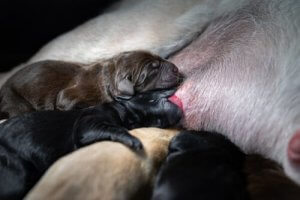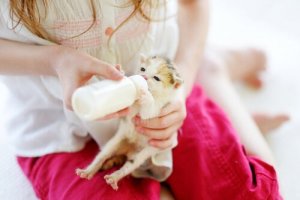The Benefits of Colostrum for Puppies and Kittens


Written and verified by the biologist Ana Díaz Maqueda
Nursing and subsequent weaning are critical life stages when it comes to nutrition in newborn animals, and have a huge impact on their development. As always, nursing starts with colostrum for puppies and kittens.
This substance can only be created by the mother – there’s no synthetic substitute. However, there are substitutes for the mature milk produced later on. These milk replacement formulas can be used in special circumstances, such as if the mother dies, her litter is too large, or she’s unable to produce enough milk.
Colostrum is essential for puppies and kittens. Their health and very survival depend on it.
What is colostrum?
Colostrum is the first milk produced by female animals after giving birth to their young. It’s mainly made up of immunoglobulins. The concentration of these large proteins is twice as high in colostrum as it is in mature milk. In other words, colostrum has double the protein content.
Even so, the most important thing about colostrum is its high content of immunoglobulins, which function as antibodies. Colostrum provides between 90 and 95% of the animals’ passive immunity. They receive the remaining 5 – 10% while they’re still in the womb.
This means that prior to their first vaccinations, the only protection puppies and kittens have against viral and bacterial pathogens is the colostrum they receive from their mothers shortly after birth.

The differences between colostrum for puppies and kittens
Canine and feline colostrum have a very different nutritional content. In fact, every species produces a slightly different type of colostrum. However, there are similarities between the colostrum produced by different types of primates, as well as those produced by ungulates.
There are also differences in the mature milk that animals produce. For example, let’s compare cat or dog milk with cow’s milk. Cow’s milk is much lower in protein and fat, and higher in sugars. This means that it’s unsuitable for puppies and kittens.
If you’re faced with the prospect of having to bottle-feed a puppy or kitten, you need to use specially formulated milk replacers, which are far more similar to their mothers’ milk. It’s important to emphasize that these milk replacers are only a substitute for mature milk rather than colostrum, which has no synthetic substitute.
The following table shows the respective quantities of some of the main nutrients in 100 grams of colostrum and 100 g of mature milk in cats and dogs. It was extracted from Langer’s 2009 article:
| Colostrum (100 g) | Protein (g) | Fat (g) | Sugars (g) |
| Dog | 13.8 | 7.8 | 2.7 |
| Cat | 4 | 3.4 | 3.6 |
| Mature milk (100 g) | Protein (g) | Fat (g) | Sugars (g) |
| Dog | 8.0 | 9.0 | 3.0 |
| Cat | 5.5 | 4.8 | 4.0 |

The properties of colostrum for puppies and kittens
As we’ve already mentioned, colostrum is the first food puppies and kittens receive when they’re born. In fact, the same goes for all mammals. The mother will only produce this substance for the first 12 – 16 hours after giving birth. As such, her young only have a limited amount of time to drink it.
Colostrum has a higher concentration of proteins and fats than sugars. This ensures that the newborns have plenty of energy right from the start. The nutrient content varies in accordance with the animal’s natural growth rate.
Colostrum is also loaded with immune proteins that protect the young until they’re old enough to be vaccinated. It’s vital that each animal receives colostrum as soon as it’s born. Consuming it later on wouldn’t have the same effect, as the digestive system would be more mature, and would simply break down the proteins. This means that it would have no immune value.
These immune proteins or immunoglobulins remain in the bloodstream until the young are around 16 weeks old. That’s why it’s so important for owners to make sure that their puppies or kittens have received all their shots before that point. Otherwise, they would be exposed to all kinds of pathogens.
Nursing and subsequent weaning are critical life stages when it comes to nutrition in newborn animals, and have a huge impact on their development. As always, nursing starts with colostrum for puppies and kittens.
This substance can only be created by the mother – there’s no synthetic substitute. However, there are substitutes for the mature milk produced later on. These milk replacement formulas can be used in special circumstances, such as if the mother dies, her litter is too large, or she’s unable to produce enough milk.
Colostrum is essential for puppies and kittens. Their health and very survival depend on it.
What is colostrum?
Colostrum is the first milk produced by female animals after giving birth to their young. It’s mainly made up of immunoglobulins. The concentration of these large proteins is twice as high in colostrum as it is in mature milk. In other words, colostrum has double the protein content.
Even so, the most important thing about colostrum is its high content of immunoglobulins, which function as antibodies. Colostrum provides between 90 and 95% of the animals’ passive immunity. They receive the remaining 5 – 10% while they’re still in the womb.
This means that prior to their first vaccinations, the only protection puppies and kittens have against viral and bacterial pathogens is the colostrum they receive from their mothers shortly after birth.

The differences between colostrum for puppies and kittens
Canine and feline colostrum have a very different nutritional content. In fact, every species produces a slightly different type of colostrum. However, there are similarities between the colostrum produced by different types of primates, as well as those produced by ungulates.
There are also differences in the mature milk that animals produce. For example, let’s compare cat or dog milk with cow’s milk. Cow’s milk is much lower in protein and fat, and higher in sugars. This means that it’s unsuitable for puppies and kittens.
If you’re faced with the prospect of having to bottle-feed a puppy or kitten, you need to use specially formulated milk replacers, which are far more similar to their mothers’ milk. It’s important to emphasize that these milk replacers are only a substitute for mature milk rather than colostrum, which has no synthetic substitute.
The following table shows the respective quantities of some of the main nutrients in 100 grams of colostrum and 100 g of mature milk in cats and dogs. It was extracted from Langer’s 2009 article:
| Colostrum (100 g) | Protein (g) | Fat (g) | Sugars (g) |
| Dog | 13.8 | 7.8 | 2.7 |
| Cat | 4 | 3.4 | 3.6 |
| Mature milk (100 g) | Protein (g) | Fat (g) | Sugars (g) |
| Dog | 8.0 | 9.0 | 3.0 |
| Cat | 5.5 | 4.8 | 4.0 |

The properties of colostrum for puppies and kittens
As we’ve already mentioned, colostrum is the first food puppies and kittens receive when they’re born. In fact, the same goes for all mammals. The mother will only produce this substance for the first 12 – 16 hours after giving birth. As such, her young only have a limited amount of time to drink it.
Colostrum has a higher concentration of proteins and fats than sugars. This ensures that the newborns have plenty of energy right from the start. The nutrient content varies in accordance with the animal’s natural growth rate.
Colostrum is also loaded with immune proteins that protect the young until they’re old enough to be vaccinated. It’s vital that each animal receives colostrum as soon as it’s born. Consuming it later on wouldn’t have the same effect, as the digestive system would be more mature, and would simply break down the proteins. This means that it would have no immune value.
These immune proteins or immunoglobulins remain in the bloodstream until the young are around 16 weeks old. That’s why it’s so important for owners to make sure that their puppies or kittens have received all their shots before that point. Otherwise, they would be exposed to all kinds of pathogens.
All cited sources were thoroughly reviewed by our team to ensure their quality, reliability, currency, and validity. The bibliography of this article was considered reliable and of academic or scientific accuracy.
- Day, M. J. (2007). Immune system development in the dog and cat. Journal of comparative pathology, 137, S10-S15.
- Langer, P. (2009). Differences in the composition of colostrum and milk in eutherians reflect differences in immunoglobulin transfer. Journal of Mammalogy, 90(2), 332-339.
- Sánchez, C. G. LECHE MATERNIZADA PARA CACHORROS LACTANTES.
This text is provided for informational purposes only and does not replace consultation with a professional. If in doubt, consult your specialist.








